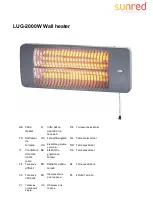
Page 14
6 - The unit may be vented vertically as a single appliance
or in a common vent with other gas-fired appliances.
In common venting situations, vent connectors for
other appliances must maintain a 4” (102mm) vertical
separation between the vent connectors. Refer to
common venting tables in the current editions of
ANSI Z223.1 or CSA-B149 installation compliance
codes for proper vent size.
7 - Gas vent clearance to combustible material is 6”
(152mm) for single-wall, metal pipe except where
a listed clearance thimble is used. Clearance to
combustible material for type B-1 vent or factory-built
chimney is per manufacturer’s instructions.
8 - The vent connector shall be supported without any
dips or sags. Vertical vents shall be supported in
accordance with their listing and manufacturers’
instructions. Any horizontal sections of vent
connector runs shall have a slope up to the vertical
vent of at least 1/4” per foot (6mm per 305mm).
9 - All vertical type B-1 vents, single-wall, metal pipe
(commercial applications), or listed chimney lining
systems must be terminated with a UL-listed (or other
equivalent agency) vent cap or listed roof assembly.
10 - The gas vent must extend at least 2 feet(0.6m)
above the highest point where it passes through a
roof of a building unless otherwise specified by ANSI
Z223.1 or CSA-B149 installation compliance codes.
The gas vent must also extend at least 2 feet(0.6m)
higher than any part of a building within a horizontal
distance of 10 feet (3m). The gas vent must extend
at least 5 feet(1.5m) above the highest connected
equipment flue collar
HORIZONTAL VENTING
NOTE -
Common venting is not allowed when horizontally
venting the unit heater.
NOTE -
Precautions must be taken to prevent degradation
of building materials by flue products.
These unit heaters are a Category III appliance when
vented horizontally.
1 -
In residential applications, horizontal gas vent
piping must be in compliance with UL 1738 for
installations in the United States, and ULC S636 for
installations in Canada. Refer to venting sections for
vent termination clearance requirements.
2 - The minimum horizontal vent length is 5 feet(1.5m).
3 - Refer to table 4 for maximum horizontal vent lengths.
4 - If possible, do not terminate the horizontal vent through
a wall that is exposed to prevailing wind. Exposure
to excessive winds can affect unit performance. If
such a termination is necessary, use a wind block to
protect the vent termination from direct winds.
5 - Vent terminations must be free from obstructions
and at least 12” (305mm) above grade level and
maximum snow height.
6 - Do not install a horizontal vent termination directly
below roof eaves or above a public walkway, or
any other area where condensate dripping may be
troublesome and may cause some staining. Avoid
windows where steam may cause fogging or ice
buildup.
7 - Minimum clearance for horizontal vent termination
from any door, window, non-mechanical air supply
inlet is 4 feet (1.2m) below or to the side of opening;
1 foot (0.3m) above opening horizontally for United
States installations. In Canada, minimum clearance
for horizontal vent termination from any door, window,
non-mechanical air supply inlet or the combustion air
inlet to any other appliance is 12 inches (305mm) for
appliances >10,000 to 100,000 Btuh, and 36 inches
(914mm) for appliance >100,000 Btuh.
8- Vent terminal clearance to each side of a centerline
extended above a meter/regulator assembly and
service regulator vent outlet must be in accordance
with local installation codes and the requirements of
the gas supplier for installations in the United States.
In Canada the clearance to each side of a centerline
extended above meter/regulator assembly and
service regulator vent outlet must be 3 feet(1m) within
a height 15 feet (4.5m) above the meter/regulator
assembly and 3 feet (1m) to a service regulator vent.
9 - Vent termination clearance to an unvented soffit or
within 2 feet (0.6m) horizontally of a ventilated soffit
must be in accordance with local installation codes
and the requirements of the gas supplier.
10 - When a vent termination is inside a corner formed
by two exterior walls the clearance must be in
accordance with local installation codes and the
requirements of the gas supplier.
11 - Vent termination must be a minimum of 3 feet(1m)
above any forced air inlet (includes fresh air inlet for
other appliance, such as a dryer) if within 10 feet
(3m) horizontally for United States installations. In
Canada, vent termination must have 6 feet (2m)
minimum clearance to a mechanical air-supply inlet
of any building.
12 - When termination is routed through combustible
wall, vent termination must be supported using a
firestop to maintain clearances specified on unit
rating plate. Inside edge of vent termination must
be at least 16” (406mm) from outside wall
TABLE 4
MAXIMUM HORIZONTAL VENT CONNECTOR AND
HORIZONTAL VENT PIPE LENGTHS
No. of
Elbows
30, 45, 60, 75, 90, 105, 125,
150, 175, 200, 350, 400
250 & 300
ft
m
ft
m
1
25
7.6
35
10.7
2
20
6.1
30
9.1
3
15
4.6
25
7.6
4
10
3.0
20
6.1
5
5
1.5
15
4.6
6
-
-
10
3.0
7
-
-
5
1.5













































